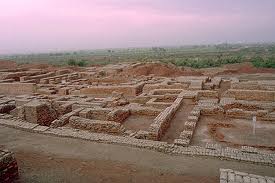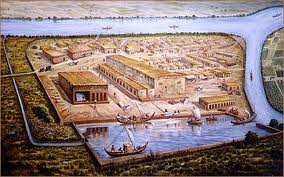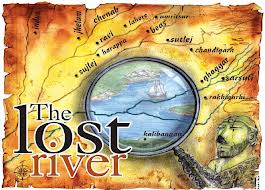
German Indologist Max Muller popularized the Aryan Invasion theory (AIT) in 1853 CE. According to the Aryan Invasion Theory, propagated by the Westerners, northern India was invaded and conquered by nomadic, light-skinned race of a people called ‘Aryans’ who supposedly descended from some unknown land around 1,500 BCE. These invaders destroyed an earlier Dravidian civilization who lived in the Indus Valley and then imposed upon them their culture (Veda-s) and language (Sanskrit)! This ‘Aryan Invasion Theory’ challenges the very basis of Indian nationhood and its Vedic culture. Therefore, we need to systematically analyze archaeological, historical and scriptural evidences to debunk this theory.
None of the ancient Vedic scriptures or epics or Purana-s mention about any Aryan migration or invasion or the Aryan race. Nowhere in the Sanskrit literature, the term Arya denotes a racial people. In Vedic literature, the real meaning of the word ‘ARYA’ is gentleman, good natured, righteous person, or a noble man. Arya is often used like ‘Sir’ or ‘Shree’ before the name of a person like Aryaputra or Aryakanya. In Valmiki Ramayana, Rama is described as an Arya in the following words: ‘Aryah sarvasamashchaivah sadaiv priyadarshan’ (a person who cared for the equality to all and was dear to everyone).
If the Aryans were outsiders, why didn’t they name places outside India as their most holy places, once they ‘conquered’ India? Why did they sing praises and bestowed the status of goddesses and gods to peninsular India’s numerous rivers and mountains. If Aryans were outsiders why did they consider India as the ‘holy land’ and not their original land as the ‘holy land’ or motherland? For the Muslims, their holy place is Mecca. For the Christians it is Rome or Jerusalem. For the Hindus, their pilgrim centers range from Kailash in the North, to Rameshwaram in the South; and from Hingalaj (Sindh) in the West to Parushuram kund (Arunachal Pradesh) in the East. The 7 holy cities of Hinduism include Kanchipurum in the south, Dwaraka in the west and Ujjain in central India. The 7 holy rivers glorified in the Vedic scriptures chart out the map of the holy land. The Rivers Saraswati, Sindhu, Ganga and the Yamuna originate from the Himalayas and move towards the different oceans. River Narmada starts in central India and the Godavari starts in western India, while the Kaveri winds its way through the south to move into the southern sea. No Hindu from any part of India has felt a stranger in any other part of India when on a pilgrimage.
‘History of India’ by MS Elphinstone, first governor of Bombay Presidency, 1819-27 states:
“…To say that it (Hinduism) spread from a central point is an unwarranted assumption, and even to analogy; for, emigration and civilization have not spread in a circle, but from east to west. Where, also, could the central point be, from which a language could spread over India, Greece, and Italy and yet leave Chaldea, Syria and Arabia untouched? There is no reason whatever for thinking that the Hindus ever inhabited any country but their present one, and as little for denying that they may have done so before the earliest trace of their records or tradition.”
 Archaeological excavations
Archaeological excavations
Tools crafted by proto-humans that have been dated back two million years have been discovered in the northwestern part of India. Isolated remains of Homo-erectus in Hathnora in the Narmada Valley in central India indicate that India might have been inhabited since at least, somewhere between 200,000 and 500,000 years ago.
Human skeletons were excavated from the buried townships at Harappa and Mohenjo-daro on the Ravi and Sindhu rivers in 1922 CE. These prove that no massacre ever took place at these townships by any invading army.
‘Archaeology and Language: The Puzzle of Indo-European Origins’ by Colin Renfrew, Prof. of Archaeology at Cambridge and also ‘The Mythical Massacre at Mohenjo-daro’, Expedition Vol VI by Prof. GF Dales (former head of department of South Asian Archaeology and Anthropology, Berkeley University, USA) state:
“Nine years of extensive excavations at Mohenjo-daro (1922-31) – a city of three miles in circuit – yielded the total of some 37 skeletons, or parts thereof, that can be attributed with some certainty to the period of the Indus civilizations. Some of these were found in contorted positions and groupings that suggest anything but orderly burials. They were all found in the area of the Lower Town – probably the residential district. Not a single body was found within the area of the fortified citadel where one could reasonably expect the final defense of this thriving capital city to have been made. Where are the burned fortresses, the arrow heads, weapons, pieces of armour, the smashed chariots and bodies of in the invaders and defenders? Despite the extensive excavations at the largest Harappan sites, there is not a single bit of evidence that can be brought forth as unconditional proof of an armed conquest and the destruction on the supposed scale of the Aryan invasion.“
Earlier, it was argued that the Aryans were horse riding and used chariots for transport. Since no signs of horses were found at the sites of Harappa and Mohanjo-daro, the habitants of Indus valley cannot be Aryans. In the 1930’s, the excavation of ‘mature Harappan’ and ‘late Harappan’ sites along Indus valley and along the dried River Saraswati produced bones of both domesticated and combat horses. This debunked the non-Aryan theory of the Indus valley habitants and also identified the Vedic culture with the Indus valley civilization.
Further, the promoters of AIT say that the terra-cotta lumps found in the Harappan and other sites are Shivalinga-s. They imply that God Shiva was worshipped in the Indus valley and later moved to the South, and therefore the earlier habitants of Indus valley were Dravidians. But these terra-cotta lumps were not Shivalinga-s for worship, but weight measurements. These were measures for weighing of the commodities by the traders. Their weights have been found in perfect values like 1 gm, 2 gms, 5 gms, 10 gms etc.
God Shiva’s worship is not confined to South India only. Most important pilgrimages are located in North India like Kashi, Kailash mountain, Kedarnath etc. The 12 jyotirlingas are located all over India including Rameshwaram in Tamil Nadu, Srisailam in Andhra Pradesh, around Nashik in Maharashtra, near Ujjain in Madhya Pradesh, Somnath in Gujarat and Kashi in Uttar Pradesh. Also, South India could not be uninhabited before this push from the north. In any case, would the original inhabitants of South India accept the newcomers from North without any fight?
Biologically, both north and south Indians all are of the same type. Only when closer to the equator the skin gets darker due to the higher influence of heat. A September 2009 path-breaking study was done by Harvard School of Public Health and India’s Centre for Cellular and Molecular Biology on ancestral Indian populations. The study analyzed 500,000 genetic markers across the genomes of 132 individuals from 25 diverse groups from 13 states. All the individuals were from 6 language families and different castes and tribal groups. It was impossible to distinguish between castes and tribes since their genetics proved they were not systematically different. The study concluded that there is a genetic relationship between all Indians and more importantly, the difference between north and south Indians might be a myth, thus re-writing history.
Lastly, there are verses in Rig Veda which mention God Shiva and Rudra as an important deity. Indra himself is called Shiva several times in Rig Veda (2.20.3, 6.45.17, 8.93.3). So, God Shiva is not a non-Vedic god.
 Conflict between Vedic and Iranian people:
Conflict between Vedic and Iranian people:
The many references to various wars and conflicts in Rig Veda were frequently cited as the proof of an invasion and wars between invading ‘white-skinned’ Aryans and ‘dark-skinned’ indigenous people. But they are actually conflicts between the forces of nature or between Deva-s and Asura-s.
At one time Vedic people and Iranians lived harmoniously practicing Vedic culture. But at some point, due to some serious philosophical dispute, the society got divided and one section moved to further north-west, to now what is known as Iran. The Iranians not only called their God Ahura (Vedic Asura) and their demons Daevas (Vedic Deva-s), but they also called themselves Dahyus (Vedic Dasyus). Vedas even mention the gods of Dasyus as Arya also. The oldest Iranian texts depict the conflicts between the Daeva-worshippers and the Dahyus, just as the Vedic texts depict them on behalf of the Deva-worshippers and Asura-s. Indra, the king of the Deva-s, is represented in the Iranian texts by a demonic Indra. This was an internal fight. It was not any invasion by ‘Aryan’ outsiders on the ‘non-Aryan’ indigenous people.
Dwaraka and River Saraswati discovered
Earlier, the AIT advocated that the Mahabharata epic was a fictional work of a highly talented poet or if not fictional, the war happened only around 1,500-1,000 BCE. In Mahabharata’s Musal Parva, God Krishna forewarns the residents of Dwaraka to vacate the city as the sea would soon submerge it. Between 1984-88, Dr. SR Rao and his team of the Indian Marine Archaeology Unit unearthed the ruins of the submerged city of Dwarka off the Gujarat coast. They found artefacts dated prior to 3,000 BCE. The discovery of the submerged city Dwaraka is very significant evidence in discarding the Aryan invasion as well as its proposed date of 1,500 BCE. Its discovery and similarity with the Harappan civilization, not only establishes the authenticity of Mahabharata war but also clinches the traditional antiquity of Mahabharata.
Rig Veda mentions the holy River Saraswati is mentioned at least 60 times, while River Ganga is mentioned only once. Extensive research by the late Dr. Wakankar has shown that the River Saraswati changed her course several times, going completely dry around 1,900 BCE. The latest satellite data combined with field archaeological sites have shown that the great pre-historic River Saraswati was over 7 kilometers wide. The Saraswati that flowed ‘from the Himalayan mountain to the sea’ is now seen to belong to a date long before 3,101 BCE (Mahabharata era). This also indicates that the Vedas are much older than the Mahabharata era, which mentions the drying of River Saraswati.
The discovery of the archaeological remains of Vedic altars at Kalibangan, deciphering the Indus script as belonging to Vedic Sanskrit family, archaeologists like Prof. Dales, Prof. Allchin etc. concluded that the Indus-valley civilization moved because of a series of floods.

Further, over 2,500 settlements like Ropar in Punjab, Lothal and Dhaulavira in Gujarat have been unearthed by various archaeologists. These stretch from Baluchistan down to Tapti valley, covering nearly a million and half square kilometers. These are mostly concentrated along the now dried up River Saraswati. Around the same time (1,900 BCE), there were constant floods and prolonged droughts along River Sindhu. This, and the catastrophic drying up of the River Saraswati led to the abandonment of the settlements by the Vedic people, and not any invasion. The highly civilized and prosperous Vedic inhabitants of the Indus-Saraswati valleys moved slowly and continuously towards the south east and even towards European regions.
In recent times, when these barbaric Europeans invaded India, they were so much in awe with the richness of culture and knowledge of native Indians, that they copied our ideas and (Sanskrit) language back to their homeland! So-called experts like Max Muller were paid to either discredit this knowledge or claim credit for it.
 Conclusion
Conclusion
When Max Muller could not support his AIT theory he recanted that Aryan meant only a linguistic family and never applied to a race and said, “If I were to look over the whole world to find out the country most richly endowed with all the wealth, power and beauty that nature can bestow, in some parts a very paradise on earth, it should point to India.“
But the damage was already done. Later, the German political Nazi group exploited the AIT to promote the racial supremacy of the white people. This started World War II and culminated in the holocaust of millions of innocent people.
Further, in the absence of archaeological and scriptural evidences for AIT, nowadays Aryan Migration Theory (AMT) is being promoted. AMT states that Aryans migrated peacefully into India and pushed the native Dravidians southwards. But journals like Nature and American Journal of Human Genetic state that there was no significant addition to the Indian gene pool in the past 3,500 years. Further, barbaric invaders or nomadic migrants just cannot produce the pure and sublime Vedic wisdom of the highest order. Veda-s preach a universal philosophy of harmony for the entire mankind, unlike the barbaric mindset of medieval Europe and the middle-east.
So, how can all these obvious anomalies and serious flaws be reconciled? By accepting the truth that the so-called Aryans were the original habitants of the townships along the Indus, Ravi, Saraswati and other rivers of the vast regions of the Indian subcontinent. And no invasion by nomadic hordes from outside India ever occurred and the civilization was not destroyed. The population simply moved to other areas due to natural calamities. Western and Far-eastern travelers who have documented their experiences during their prolonged stay in India have testified the importance of Vedic literature and its indigenous origin.
Famous author Mark Twain said:
“India is the cradle of the human race, the birthplace of human speech, the mother of history, grandmother of legend, and great grand mother of tradition. Our most valuable and most instructive materials in the history of man are treasured up in India only.”

